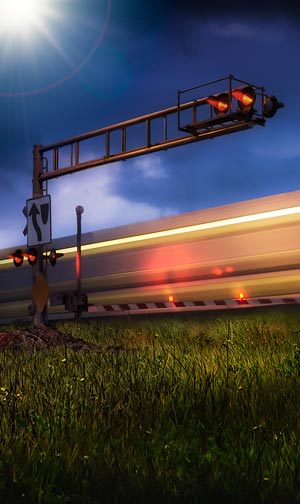Deadly Crossing Scheduled to Get Lights, Gates Sometime in the Future
(Lawrence, Kansas – September 3, 2012)
The Burlington Northern Santa Fe Railway crossing of East 950 Road in Douglas County, KS, near Lecompton, KS, where a 22-year-old motorist was killed by a BNSF freight train on February 4, 2011 – 17 months ago – now has the promise of an active protective system, even though such is still plenty of paperwork and probably still over a year away.
Under the yet-to-be-finalized agreement, the crossing where Kyle Snyder was killed when his northbound pickup collided with an eastbound BNSF freight train, will receive safety improvements, with the Kansas Dept. of Transportation providing 80% of the funding for lights, bells and gates, while BNSF picks up the remaining 20% of the estimated $250,000 cost.
The crossing, which also lies at the bottom of a steep decline of Douglas County East 950 Road from its crest to the railroad tracks, has been “protected” for years by standard, passive railroad crossbuck signs, deemed sufficient protection from what the Federal Railroad Administration says is a daily average of seven trains, including Amtrak passenger trains, that cross there at a maximum allowable speed of 79 mph. Both FRA and KDOT estimates agree that there are less than 40 highway vehicles using the crossing daily, but this figure includes school buses on occasion.
Although officials say that icy and snow packed conditions were contributing factors to the 2011 tragedy, Tom Snyder, the victim’s father who, along with his wife, Laury, Kyle’s mother, have battled for safety additions at the crossing, says that the main safety improvement will be the flashing lights, giving motorists a warning of an approaching train before they begin descending the grade that leads to the railroad tracks. Snyder also feels the crossing should be closed during inclement winter weather conditions, such as were the case when his son was killed, saying “A school bus cannot be traveling down that hill.”
KDOT Coordinating Engineer Mitch Smothers agrees, saying that the signal “will improve safety. It will give people on their approaches advanced warning of a train.”
But the safety improvement factor is nowhere near imminent, as once the paperwork is complete and the agreement is actually signed by both KDOT and BNSF, the railroad will still have a year – 12 more months – to complete the installation of the gates, bells and lights. Meanwhile, the usual railroad ambiguity is displayed as BNSF spokesman Joe Faust, while admitting to having no familiarity with the crossing, maintains the rhetoric by telling the Lawrence Journal-World that “state and local officials make the call on the level of protection needed at a railroad crossing”, adding that “BNSF would be responsible for installing and maintaining the equipment going forward.”


